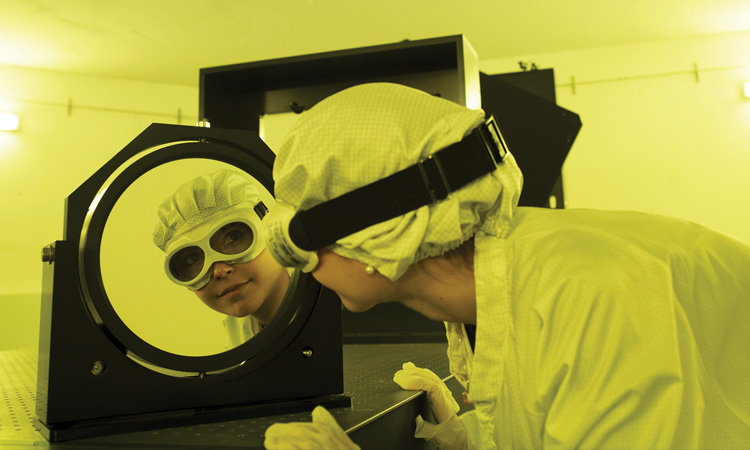 [Getty Images]
[Getty Images]
When Alexis Vogt had wrapped up her Ph.D. and set off on an industry career, one of the companies she worked at in the mid-2010s was an optical-systems firm in the Rochester, NY, area serving the health and medical market. And, she says, it didn’t take her long in the job to find out who the most important person in the company was. It was Dennis.
“We would have these standing-only meetings every morning,” Vogt recalls. “And someone would say ‘The number-one customer is paying double; this has to go out today,’ and someone else would say, ‘Dennis isn’t here.’ Then we’d talk about a different project needing to happen, and someone would say, ‘Dennis can’t get to that today.’ … We literally didn’t ship product out the door when Dennis wasn’t there.”
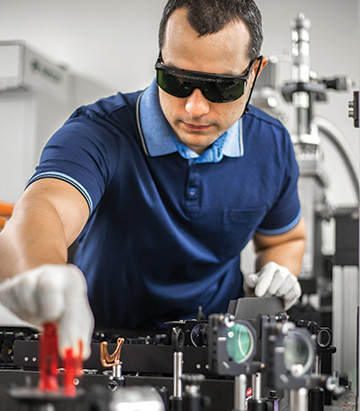 [Getty Images]
[Getty Images]
Dennis, it turned out, was the company’s lead optics technician—the holder of a two-year associate degree from a program at nearby Monroe Community College (MCC) that trains such personnel. And Vogt, who has since left industry to lead that same program at MCC, also learned that her former company’s workflow bottleneck was the tip of a very large iceberg: a persistent, worldwide shortage of qualified technicians in optics and photonics.
Such technicians are the skilled laborers who actually set up optical tables and lasers, install, align, test and repair state-of-the-art equipment, and perform a range of other responsibilities to keep R&D labs productive and shop floors humming. And the optics business continues to struggle to find enough qualified personnel for such roles to support the industry’s growth. OPN talked with a number of people working on ways to fill the technician pipeline.
Stubborn problem
The shortage of qualified optics and photonics technicians isn’t a new concern. In mid-2006, for example, Daniel Hull and John Souders, under a grant from the US National Science Foundation’s Advanced Technological Education (ATE) program, set up the National Center for Optics and Photonics Education (OP-TEC) precisely to advance high-school and community-college programs that train such personnel—through curriculum and instructional-material development, needs assessments and a fair amount of evangelism. In a 2009 paper, Hull and Souders wrote of an “urgent need for technicians in optics and photonics,” and cited statistics pointing to a significant shortfall of qualified personnel.
Since then, the need has only grown, as emerging areas such as integrated photonics and advanced manufacturing have stoked demand for technicians—even as the pipeline of qualified students has dwindled. A February 2021 study commissioned by AIM Photonics and executed by the Massachusetts Institute of Technology Office of Open Learning projected that the US optics and photonics industry might require as many as 3,500 newly minted “middle-skilled workers” annually through the end of the decade, including some 2,200 new engineering technicians per year.
At current graduation rates, that suggests the need for some 140 associate-degree-granting training programs in the United States alone, according to the study—roughly seven times the number active in the country today. “I knew there was a need,” says Natalia Chekhovskaya, the principal investigator for LASER-TEC, the NSF-funded successor to the earlier OP-TEC program. “But what I saw in the [AIM Photonics] numbers made me hold my heart. We are so far behind.”
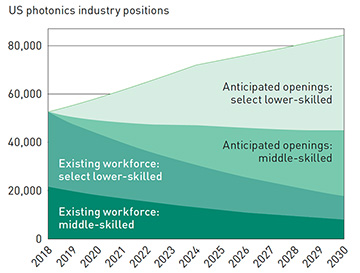 Research commissioned by AIM Photonics and published in 2021 found that, factoring in expected retirements, the US fiber-optics and integrated-photonics industry might need to add as many as 3,500 new middle-skill workers per year through the end of the 2020s—including some 2,200 engineering technicians per year. [Enlarge graphic] [R. Kirchain et al., “Preparing the advanced manufacturing workforce,” AIM Photonics and MIT Office of Open Learning (Feb. 2021).]
Research commissioned by AIM Photonics and published in 2021 found that, factoring in expected retirements, the US fiber-optics and integrated-photonics industry might need to add as many as 3,500 new middle-skill workers per year through the end of the 2020s—including some 2,200 engineering technicians per year. [Enlarge graphic] [R. Kirchain et al., “Preparing the advanced manufacturing workforce,” AIM Photonics and MIT Office of Open Learning (Feb. 2021).]
And it’s not just a US problem. In Europe, for example, the Strategic Research and Innovation Agenda assembled in 2020 by the Photonics21 public–private partnership stressed the need to build a skilled photonics workforce to meet the European Union’s ambitious goals for digital innovation, “technological sovereignty,” economic growth and a host of other areas. The report called for a “pan-European” approach to advance photonic training and knowledge not only in undergrad and graduate academia, but also in the vocational- and professional-education contexts where the training of technicians happens.
“This is something that companies in photonics worry about,” says Roberta Ramponi of Politecnico di Milano, Italy, who coauthored the section of the Photonics21 agenda centered on education and training. “While it’s quite easy to find technicians that are skilled in electronics, it’s not so easy to find a technician in photonics.”
Filling the gap
In the United States, much of the effort to fill the technician gap falls to a handful of two-year degree and certificate programs at community colleges and technical schools. Chekhovskaya’s LASER-TEC tracks a network of 44 partner colleges with some kind of coursework in photonics; of those, she says, only around 20 have actual associate-degree or certification programs. Moreover, those programs tend to depend on small numbers of committed faculty who are passionate about training technical staff. “Those [20] colleges don’t operate at maximum capacity now, because of the enrollment crisis and a lack of faculty available to teach,” Chekhovskaya says. “It’s usually a one-man show or a one-woman show.”
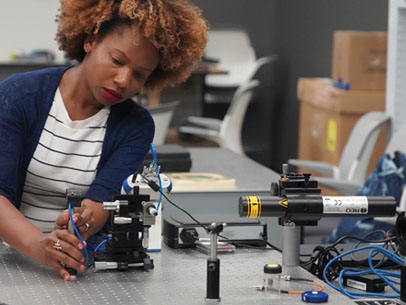 A student in the LaserTech program in Southern California. [Courtesy of Irvine Valley College]
A student in the LaserTech program in Southern California. [Courtesy of Irvine Valley College]
Sometimes, those faculty members are training technicians even as they hold down full-time jobs elsewhere. Brian Monacelli, who works by day as an optical engineer and technical-group supervisor at the Jet Propulsion Laboratory in Pasadena, CA, USA, also runs the LaserTech technician-training program at Pasadena City College (PCC), teaching the courses in the evening. “Historically that’s been best for my students,” he says, as many come from industrial jobs and need to attend after work.
Monacelli, Chekhovskaya and others point out that these programs are usually tuned to the needs of the local photonics community or cluster in the region where college operates.
Interestingly, Monacelli says between 20% and 40% of his LaserTech students are engineers or technicians who, during their undergrad education, “didn’t learn the optical hardware skills” and want to gain those abilities. The remainder are career technicians, who “will earn a two-year degree and come out with something that will be immediately useful on the shop floor.”
Local heroes
Monacelli, Chekhovskaya and others point out that these programs are usually tuned to the needs of the local photonics community or cluster in the region where college operates. “Each college needs to tailor its curriculum to the industry needs and presence,” Chekhovskaya says. For example, the program at Florida’s Indian River State College, where she is based, tends to focus on lasers used in biomedical applications, fiber optics, communications and other areas that are important in the Florida photonic cluster. Programs in the US Midwest, in contrast, might focus on high-power lasers used in manufacturing.
Monacelli says his Southern California program, while providing a firm underpinning in the basics, emphasizes skills related to system integration and development, in line with the needs of local industries such as aerospace and medical devices. Vogt’s MCC program in the Rochester area, meanwhile, focuses on optical fabrication, precision optics and related areas. Indeed, she notes that the program, which dates back to the 1960s, was originally “largely started” by Eastman-Kodak, Bausch & Lomb and Xerox to serve as a “feeder program” to staff the Rochester area’s thriving optical industry.
There are also some intriguing exceptions to the rule. Michael Shay runs an associate-degree-granting technician-training program at Indian Hills Community College (IHCC) in Ottumwa, IA, USA—a place far removed from any local optics or photonics cluster. “We are not in a big city,” Shay says of the program, which he joined in 2015 but which has existed for several decades. “We are not surrounded by tech giants and industry.” His students, he says, “know from day one” that when they finish the program, they will have to move to gain employment.
Still, at a time of intense unmet industry demand for skilled technicians, IHCC’s location doesn’t seem to have hurt job prospects for graduates of the school’s 21-month program. Shay says that for his most recent graduating class of eight students, 16 companies showed up for face-to-face interviews and another 27 companies reached out for contact information, resumes and references—with interested parties ranging from the Lawrence Livermore National Laboratory in California to IDEX Health and Science in New York.
“I had several companies that would say, ‘We want all of your students; we can hire all of them,’” according to Shay. Monacelli concurs. “I always have more job opportunities than I have students graduating,” he says. “That’s been the case for the 15 years I’ve been teaching in this field.”
Amid such demand, salaries are rising, too. “We’re in a situation where the students are making more than the faculty,” says Vogt. “It’s really remarkable what a two-year degree can afford you in our field.”
“We’re in a situation where the students are making more than the faculty,” says Vogt. “It’s really remarkable what a two-year degree can afford you in our field.”
Supporting the community
A number of efforts are afoot in the US to improve and expand the infrastructure for training optics and photonics technicians. LASER-TEC, the NSF-funded initiative now headed up by Chekhovskaya, maintains a website that serves as a clearinghouse for curriculum information, course modules, lab materials and other information relevant to technician training in the United States.
Many of the course materials build on the earlier OP-TEC effort; Chekhovskaya says LASER-TEC is continually working to update those materials to reflect new developments, technologies and systems. (For example, one such update, last year, involved wideband semiconductor technology, which is starting to become important in high-power laser systems.) The group keeps tabs on industry and community needs through ongoing research, regular surveys, and input from a national visiting committee that “guides us through emerging areas,” says Chekhovskaya.
There’s also, Chekhovskaya adds, an effort to tap the wisdom of faculty members, by putting LASER-TEC materials online as open educational resources (OERs). “We are pushing everything to the OER domain, because we want to broaden the access to those materials … to get them into the hands of those who can make them better,” she says. “We’re definitely relying on the expertise of other faculty members to help us identify gaps.” Monacelli, who has developed courses for LASER-TEC to suit his program’s specific needs, also is a big believer in OER and has made all of his curricula open under an NSF grant.
One particular advantage of that approach, Monacelli says, is that it facilitates industry review and feedback, which, he notes, “really does help with the teaching part.” Indeed, partnerships with industry are key to making many of the training programs work—as a source not only of feedback, but of valuable donated equipment and classroom and on-site demos. “Industry is really at the center of everything we do,” stresses Chekhovskaya.
Monacelli, whose program benefits from its location in technologically rich Southern California, has forged collaborative relationships with local firms such as Precision Optical, Trioptics and Diverse Optics, including class visits to the companies’ shop floors. Yet even programs not planted in a photonics cluster can benefit. Shay says his program at IHCC in Iowa, for example, has received generous donations from Trumpf, not only of equipment but also of maintenance and training time, even though he doesn’t have “tons of students” going to work for the firm. And alumni of the program employed in industry, Shay adds, also work hard to direct equipment donations to the school. “Those are the people that are keeping the program going,” he says.
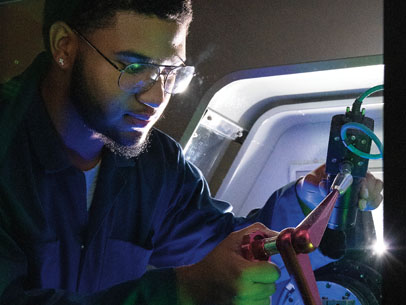 The technician-training program at Monroe Community College focuses on precision optics and optical fabrication. [Courtesy of AmeriCOM]
The technician-training program at Monroe Community College focuses on precision optics and optical fabrication. [Courtesy of AmeriCOM]
Expanding via AmeriCOM
Vogt says the advocacy of local industry and its help in finding adjunct faculty were essential to saving the MCC technician-training program in the mid-2010s, when the college was considering shutting it down in the face of dwindling enrollments. Shortly thereafter Vogt took over, and has now worked there for more than seven years, with a mandate to rebuild and grow the program.
She’s had success. Whereas, when she started at MCC, the technician-training unit had only five students, in the class of 2022 the program graduated the largest class in its history—21 students with associate’s degrees in precision optics and another 27 with certificates. Vogt also snagged a US$4.4 million grant from the US Office of Naval Research that’s being used to “have a more nationwide presence,” through online education, a planned nationwide precision-optics apprenticeship program, efforts to build gender, racial and ethnic diversity among optics technicians, and outreach to high-school and post-secondary-school students and teachers.
Even more ambitious is the American Center for Optics Manufacturing (AmeriCOM), an initiative started in September 2021 that’s backed by a five-year, US$34 million grant from the US Department of Defense, and in which Vogt serves as executive director for workforce and higher education. AmeriCOM is a consortium of government, industry and academic partners working to advance precision optics, partly through workforce development. Among other things, Vogt says, AmeriCOM is providing funds for community colleges to purchase “the really expensive equipment” that’s often cost-prohibitive for these locally based programs. It’s also working to organize and create a curriculum database for precision-optics technician training.
AmeriCOM has framed the lofty goal of a 16-fold increase, by 2025, in the number of skilled precision-optics technicians coming out of such programs each year. “It’s ambitious, for sure,” Vogt admits. “But the industry actually needs more than that number of people.” And, while she notes that AmeriCOM is explicitly focused on precision optics and, not surprisingly, on programs serving regions active in defense-related work, Vogt thinks the marketing and outreach efforts being funded by AmeriCOM should benefit the entire community-college ecosystem for training optics and photonics technicians in the United States.
UK and Europe: A perennial issue
The photonics industries in the United Kingdom and the European Union are facing their own technician challenges—and have devised some interesting approaches to address the issue. Alison McLeod, a physicist who oversees the Photonics Scotland cluster of the industry group Technology Scotland, UK, notes that in the group’s annual surveys, “the biggest impediment to growth” cited by members is a lack of skills, and difficulty getting the right people to fill available jobs.
“Skills has been an issue highlighted in all our annual surveys to date,” McLeod says. “And we know it’s not just Scotland, it’s not just the UK, it’s not just Europe—it’s a worldwide thing at the moment.”
In her corner of the world, McLeod says, one recent initiative has been a practical photonics-skills course set up under Scotland’s National Translation Training Fund, to aid workers aged 25 and older who had been or were at risk of being “made redundant” as a result of the pandemic. The five-day, bootcamp-like course was developed with the aid of the National Manufacturing Institute of Scotland, as well as the four biggest photonics employers in Scotland and a smaller firm, Chromaticity, with Photonics Scotland providing a voice for other small and medium-sized enterprises (SMEs). The course includes elements ranging from cleanroom practice and laser safety to basic beam steering and linking lasers into optical fiber.
The first instance of the course, provided through the University of Strathclyde’s Institute of Photonics in August 2022, yielded good results, according to McLeod—with a number of the students subsequently offered jobs, and with space made (and language translation arranged) for several Ukrainian refugees. The course will run again in April 2023. McLeod says it’s just one of several initiatives being discussed to advance Scotland’s photonics workforce and “feed the skills funnel.”
Training and reskilling via PhotonHub Europe
In the European Union, workforce development, including on the technician level, is also seen as central to the long-term success of photonics. “It’s not only a problem of financing the development of the technology,” says Roberta Ramponi. “The big issue is also to have enough of a well-experienced workforce, and to maintain the workforce with the new results of knowledge and technology in the field.” To meet that need, the photonics community in the EU, as in other regions, is pursuing multiple efforts to “have some coordination and share good practice,” and otherwise fill the workforce pipeline.
“It’s not only a problem of financing the development of the technology,” says Roberta Ramponi. “The big issue is also to have enough of a well-experienced workforce.”
One pan-European effort is the training-and-reskilling component of PhotonHub Europe, a €19 million, European Commission–funded project to drive photonic innovation among companies across a wide spectrum of industry domains. Hugo Thienpont, the director of the B-PHOT research group at Vrije Universiteit Brussel, Belgium, who leads the project, describes PhotonHub Europe as bringing together a variety of services into a “one-stop shop” for photonics and business expertise. In particular, the program targets Europe’s roughly 260,000 SMEs in sectors ranging from security to space and defense to food to smart cities and Industry 4.0.
“Most of those industry sectors don’t know what photonics is,” says Thienpont, “or what photonics in innovation can do for them.” PhotonHub Europe—which includes 56 industry and academic partners—assists such firms through a range of services: a basic orientation to photonics; “deep technology support,” including feasibility studies, access to foundries and pilot lines, and expert advice for prototyping and upscaling; and workforce training and reskilling, business coaching and investment coaching, to make the leap to manufacturing and commercialization. “We listen to the challenge of the companies,” says Thienpont, “and we help them with innovation that is driven by their needs”
In the area of training and reskilling, PhotonHub Europe serves those diverse needs through a number of instruments. One is the European Photonics Innovation Academy, an online catalog that organizes and provides quick access to training offerings available across Europe. The initiative also offers a two-hour online introduction to photonics, tuned to specific industry sectors.
For companies seeking to upskill their workforces further to support photonics as part of their growth plans, PhotonHub also operates 32 “Demo Centers” and nine “Experience Centers” across Europe. The Demo Centers, as the name implies, offer one-day demonstrations of photonic technology, tuned to specific industry sectors. The Experience Centers provide hands-on training in “top-notch technology” in areas ranging from freeform optics to laser-based manufacturing, to build tangible photonics expertise the companies can take back to their manufacturing efforts.
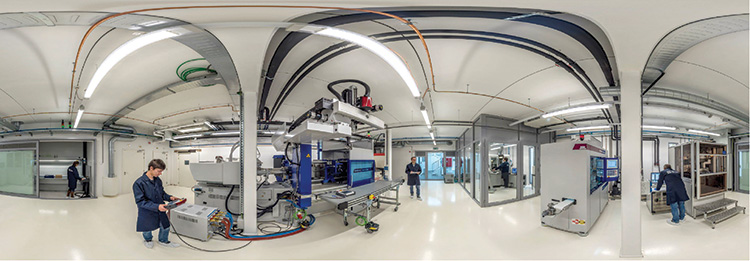 One of the “Experience Centers” run by PhotonHub Europe, focused on fabrication, offers hands-on training with injection and glass-press molding, diamond tooling and hot-embossing equipment. [Courtesy of H. Thienpont / PhotonHub Europe]
One of the “Experience Centers” run by PhotonHub Europe, focused on fabrication, offers hands-on training with injection and glass-press molding, diamond tooling and hot-embossing equipment. [Courtesy of H. Thienpont / PhotonHub Europe]
Looking ahead, Thienpont adds, PhotonHub Europe will also be rolling out a “train the trainer” program. “We’re going to try to train people who work at the technical high schools, or people who work in industry and have their own in-house training programs,” he says. “Otherwise you are training [workers] one-on-one—which is good, but which will not have the massive impact we are targeting.”
Challenging road ahead
Notwithstanding these and other community-driven efforts, building a sustainable, ongoing supply of skilled technicians remains a multifaceted challenge for the photonics business, particularly as the technology continues to evolve. Much discussion at present, for example, revolves around the need to build a new kind of workforce that can support the envisioned growth in quantum technology—and whether (and, if so, how much) optical technicians will need to know about the weird quantum world to do their jobs.
Perhaps the biggest ongoing challenge, though, is one that has dogged this area for decades: difficulty in attracting and retaining promising students who might want to pursue a technician career. Some of the difficulty may stem from unfamiliarity with photonics and how pervasive it is in modern communications, sensing and other technologies.
“That’s a massive part of it,” says Technology Scotland’s Alison McLeod. “Those of us who are in photonics know how wonderful photonics is, and how it runs through everything that we do on a daily basis. But if you’re not aware of that, then you get ‘It’s just physics; it’s difficult and I don’t want to know about it.’” Changing that mindset, she believes, will require better outreach toward school children and parents as career decisions are being made. “It’s that education piece of it—that there are all these wonderful careers,” McLeod says. “You don’t need a Ph.D for all roles in the sector. It’s not just sitting in a lab with a white coat on.”
On the other side of the Atlantic, Alexis Vogt at MCC agrees. She’s used some money from a recent grant to move her program’s introduction to optics course into 18 high schools in the Rochester area, partly in the hope of stoking awareness and interest in the MCC program as a possible launch pad to an optics-technician career. “In fact, if there’s a criticism of the work I’m doing, it’s that I’m not starting young enough,” she says, “High school is great, but at that point, you have many people who have already decided what they’re going to do”; outreach to primary- and middle-school students (and their parents) could, she suggests, be equally or even more important.
In the end, though, Brian Monacelli, who runs the PCC LaserTech program in California, believes progress will require that the optics and photonics community—traditionally viewed as the province of Ph.D.-level scientists—begins showing more tangible respect for the technician career path.
“We—as a community, as an industry—have to do more to entice people to join this fairly lucrative and rewarding field,” Monacelli says. “Unfortunately, in our society, technicians are viewed as ‘blue-collar’ workers. I couldn’t agree less … These are the people who actually touch the parts that go into complex systems—medical devices or instruments going into space. They’re the ones who, in a sense, make the dreams come true.”
Stewart Wills is the senior editor of Optics & Photonics News.
For references and resources, visit: optica-opn.org/link/0223-technicians.

